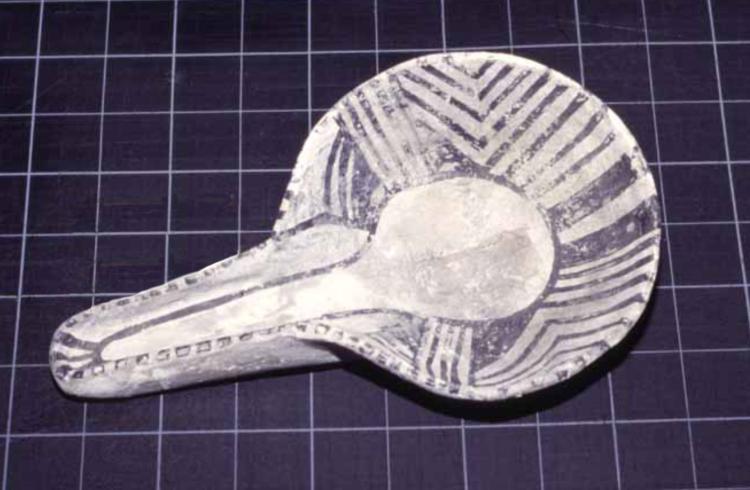
Ladles or scoops were made throughout the pre-Hispanic Southwest to be used much as we use serving spoons today. This ladle is attributed to Pueblo Indigenous peoples from 900–1150 AD, in the time referred to as Pueblo II, where Indigenous cultures continued building dwellings often nestled into the landscape1. While it is always exciting to find a whole or mostly whole vessel, what can be identified from individual ladle rim sherds is still important; many have evidence for wear on the outer edge caused by abrasion when used to scoop food or other materials out of another vessel. When archaeologists do have larger portions of the ladle bowl, it becomes possible to assess handedness of the individual who used the ladle based on which edge is abraded. These insights help archeologists craft a narrative about what the culture of these sites might have looked like hundreds of years ago, satiating a human curiosity of what came before modern times.
This McElmo (a type of pottery within the Northern San Juan Ware) black-on-white clay ladle is from the Yellow Jacket archaeological complex in southwestern Colorado. The white portion of the ladle is created using a slip—a mixture of clay and water—while the black pigment is organic, coming from plants. After firing the pottery, both colors offer striking contrast that still hold their hue to this day.
The Yellow Jacket complex, which describes a set of archaeological sites, in southwestern Colorado is the largest Mesa Verde cultural archaeological site. Dr. Joe Ben Wheat, the first curator of Anthropology at the University of Colorado Museum, directed 21 seasons of field work (between 1954 and 1991, the largest excavation in the history of the Museum of Natural History) at Yellow Jacket, excavations yielded over 300,000 objects. These objects are curated by the Museum, along with thousands of pages of archival records that are being assessed and rehoused with funding from an NEH Preservation Assistance Grant. Prior to shutdowns related to COVID-19, these assessments and rehousing were actively underway with help from CU graduate students and numerous public volunteers, under the guidance of the Museum’s new archeology curator, Dr Samantha Fladd. The scope of excavations at Yellow Jacket reflect a distinctive period of excavation in Southwest archaeology that is still being studied to this day. Today, archaeologists excavate much smaller portions of sites as this type of investigation is inherently destructive in nature.
Modern archeological investigations are harnessing technology and advancing understanding of geochemistry to keep important archeological sites intact, thus preserving the integrity of objects and land alike. Through the use of drones and satellite imagery, many aspects of settlements can be detected without digging. Ground penetrating radar and light detection and ranging technology (LIDAR) offer 3D maps to help identify objects and insights to cultural significance2. LIDAR is also able to work through vegetation, offering the ability to detect sites without disturbing any modern development or vegetative regrowth of ancient settlements, and can offer topographical information. Through these technological developments, archaeologists are better able to respect sites that are culturally important while still gathering the information about ancient peoples.
Name of object: Ladle (McElmo)
Date collected and/or acquired: Unspecified
Time period made (or lived): Pueblo II (900-1150)
General location found: Yellow Jacket, 5MT1 (Southwestern CO)
Who found/studied it: Unspecified but Joe Ben Wheat is likely
Catalog number: 22652
Sources
1. http://npshistory.com/series/archeology/2/sec2.htm
2. https://oceanservice.noaa.gov/facts/lidar.html
